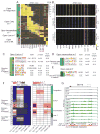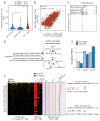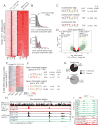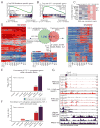Lineage-Determining Transcription Factor TCF-1 Initiates the Epigenetic Identity of T Cells
- PMID: 29466756
- PMCID: PMC5824646
- DOI: 10.1016/j.immuni.2018.01.012
Lineage-Determining Transcription Factor TCF-1 Initiates the Epigenetic Identity of T Cells
Abstract
T cell development is orchestrated by transcription factors that regulate the expression of genes initially buried within inaccessible chromatin, but the transcription factors that establish the regulatory landscape of the T cell lineage remain unknown. Profiling chromatin accessibility at eight stages of T cell development revealed the selective enrichment of TCF-1 at genomic regions that became accessible at the earliest stages of development. TCF-1 was further required for the accessibility of these regulatory elements and at the single-cell level, it dictated a coordinate opening of chromatin in T cells. TCF-1 expression in fibroblasts generated de novo chromatin accessibility even at chromatin regions with repressive marks, inducing the expression of T cell-restricted genes. These results indicate that a mechanism by which TCF-1 controls T cell fate is through its widespread ability to target silent chromatin and establish the epigenetic identity of T cells.
Keywords: Lineage-determining transcription factor; T cell development; TCF-1; chromatin accessibility; epigenetics; nucleosomes; repressed chromatin; reprogramming; single-cell epigenomics.
Copyright © 2018 Elsevier Inc. All rights reserved.
Conflict of interest statement
The authors declare no competing interests.
Figures






Comment in
-
T Cell LEGO: Identifying the Master Builders and What They Do.Immunity. 2018 Feb 20;48(2):185-187. doi: 10.1016/j.immuni.2018.02.004. Immunity. 2018. PMID: 29466746
References
-
- Boller S, Ramamoorthy S, Akbas D, Nechanitzky R, Burger L, Murr R, Schubeler D, Grosschedl R. Pioneering Activity of the C-Terminal Domain of EBF1 Shapes the Chromatin Landscape for B Cell Programming. Immunity. 2016;44:527–541. - PubMed
Publication types
MeSH terms
Substances
Grants and funding
LinkOut - more resources
Full Text Sources
Other Literature Sources
Molecular Biology Databases

